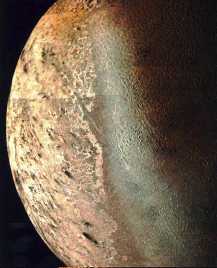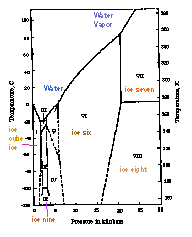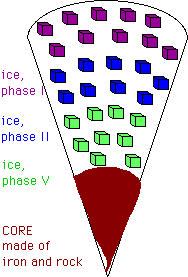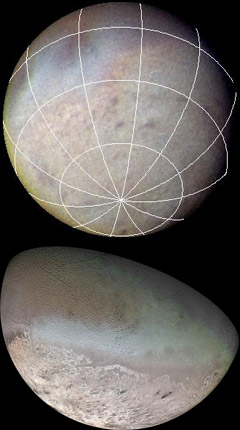This is an image of Triton.
Image from: NASA
Inside Triton
The diagram to the left shows a drawing of the possible interior of Triton. The composition of Triton is mostly ice, therefore there is probably a small core of some rocky material buried inside, overlain with mantles of ice of various phases. One of the phases of ice is water however, and if water is present it could provide and environment suitable forlife.
If the interior is warm enough, there may be enough energy for the interior layers of Triton to turn over. This type of interior motion leaves clues on the surface of a planet, such as folds and deep canyons. Surface plate tectonics is a big clue about interior motions of the Earth.
The fact that this moon is made primarily of ice suggests a certain path for it's history.
You might also be interested in:

How did life evolve on Earth? The answer to this question can help us understand our past and prepare for our future. Although evolution provides credible and reliable answers, polls show that many people turn away from science, seeking other explanations with which they are more comfortable.
...more
When the Voyager mission flew by Triton, it took the spectra of the surface. The spectra matched that of ice and also several different kinds of snow (crushed ice). The Voyager spacecraft could not measure
...more
The phase of ice means the form of ice which takes shape. There are nine different kinds of shapes the ice crystal can assume. It all depends upon what temperature the ice feels, and what pressure the
...more
Triton is most like Jupiter's moon Europa. Like Europa, the interior of Triton may have been warm enough at one time to contain a liquid layer just under the surface. On Earth, we know that there are some
...more
This beautiful image of Triton reveals many interesting features of its surface. The surface of Triton is halfway between Ganymede's and Europa's (two of Jupiter's moons). Ancient portions of the surface
...more
Triton was discovered by W. Lassell in 1846. Of the 8 moons, it is the 2nd farthest from Neptune, with a standoff distance of 354,800 km. Triton may be one of the largest of the icy moons, is comparable
...more
The diagram to the left shows a drawing of the possible interior of Triton. The composition of Triton is mostly ice, therefore there is probably a small core of some rocky material buried inside, overlain
...more
Triton is the largest moon of Neptune. It is a very unusual moon. The poles of Triton are especially interesting. Triton has a polar ice cap at the South Pole. Earth, of course, has ice caps at its poles
...more











